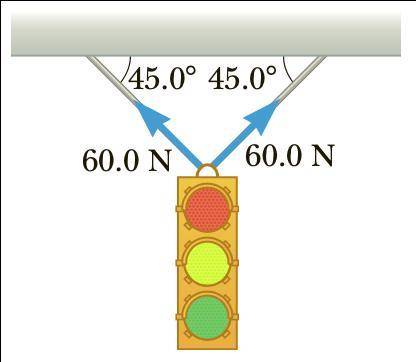
a. What is the resultant force exerted by the two cables supporting the traffic light in the figure? b. What is the weight of the light? c. If a 20-N wind blows on the traffic light to the right, what are the new tensions in each cable if the angles do not change?


Answers: 3


Other questions on the subject: Physics

Physics, 21.06.2019 21:40, lolz55678
Achemistry student needs of 40ml diethylamine for an experiment. by consulting the crc handbook of chemistry and physics, the student discovers that the density of diethylamine is 0.7 . calculate the mass of diethylamine the student should weigh out. round your answer to significant digits.
Answers: 1

Physics, 21.06.2019 23:00, xojade
Athermometer is removed from a room where the temperature is 70° f and is taken outside, where the air temperature is 10° f. after one-half minute the thermometer reads 60° f. what is the reading of the thermometer at t = 1 min? (round your answer to two decimal places.) ° f how long will it take for the thermometer to reach 30° f? (round your answer to two decimal places.)
Answers: 3

Physics, 22.06.2019 16:00, 6FOOT
The electric potential v is constant everywhere within a certain region of space. which statement below is true? the choices are: the electric field is also constant (but not zero) within the region. a charged particle placed within the region will experience an electric force. the electric field is zero everywhere within the region. the electric field varies from place to place within the region.
Answers: 2

Physics, 22.06.2019 17:00, jenn8055
In the future, people will only enjoy one sport: electrodisc. in this sport, you gain points when you cause metallic discs hovering on a field to exchange charge. you are an electrodisc player playing the popular four disc variant. the disks have charges of qa = −8.0 µc, qb = −2.0 µc, qc = +5.0 µc, and qd = +12.0 µc. (1) you bring two disks together and then separate them. you measure the resulting charge of these two disks and find that it is +5.0 µc per disk. which two disks did you bring together? (a) a and b (b) a and c (c)a and d (d)b and c(e) b and d (f) c and d. (2) you bring three disks together and then separate them. you measure the resulting charge of these three disks and find that it is +3.0 µc per disk. which three disks did you bring together? a, b, and c (a) a, b, and d (c) a, c, and d (d) b, c, and d. (3) given the resulting charge of each disk measured in (b) is +3.0 µc, how many electrons would you need to add to a disk of this charge to electrically neutralize it? electrons
Answers: 3
You know the right answer?
a. What is the resultant force exerted by the two cables supporting the traffic light in the figure?...
Questions in other subjects:

Mathematics, 09.04.2020 17:30



Mathematics, 09.04.2020 17:31



History, 09.04.2020 17:33





